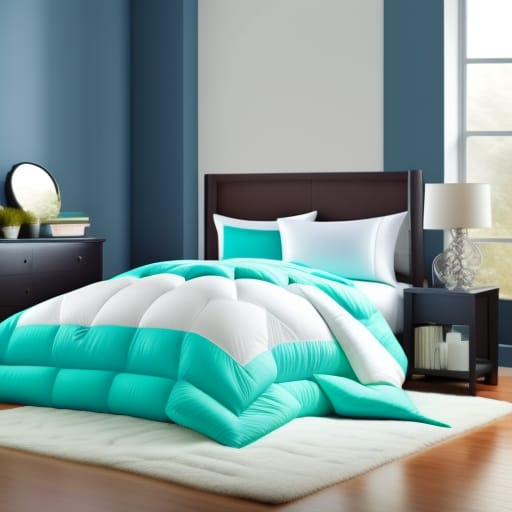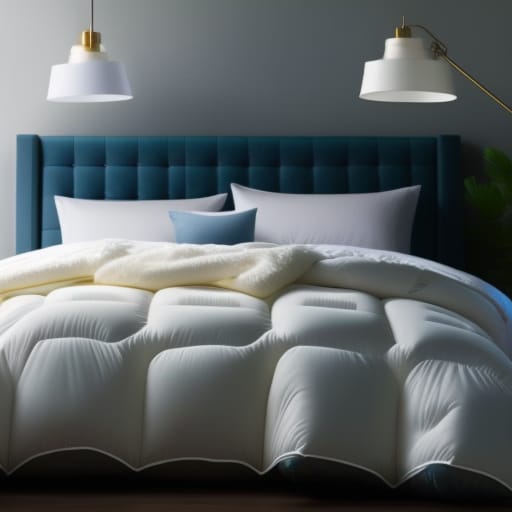Have you been considering switching your bedding to a down comforter? With their fluffy, warm, and luxurious feel, down comforters are one of the most popular bedding options. But with so many types of down comforters available, how do you choose the right one?
This comprehensive beginner’s guide will teach you everything you need to know about down comforters – from fill power to thread count, seasonal options to care instructions. You’ll learn how to select the perfect down comforter for your needs and use it properly for maximum comfort. Let’s get cozy!
What is a Down Comforter?
A down comforter is a type of duvet or quilt filled with duck or goose down clusters. The down clusters provide lightweight, breathable insulation that traps body heat to keep you warm.
Down comforters offer superior insulation compared to comforters filled with alternate materials like cotton or polyester. The fluffy down filling forms tiny air pockets that prevent heat from escaping and cold from entering.
Benefits of down comforters:
- Provide excellent warmth without excessive weight
- Highly compressible and fluffy
- Delicate and soft to the touch
- Long-lasting with proper care
- Breathable and moisture-wicking
- Luxurious look and feel
Types of Down Comforters
There are many varieties of down comforters to choose from, depending on your warmth needs and climate.
All-Season Down Comforters
All-season down comforters contain a lighter fill weight, between 400-600 fill power. This makes them ideal for year-round use in most climates. The lighter fill provides moderate warmth without overheating.
Lightweight Down Comforters
Lightweight down comforters have a fill power under 400. They offer just a touch of insulation for warm weather or hot sleepers. Lightweight options work well in the summer and warmer climates.
Heavyweight Down Comforters
Heavyweight down comforters provide extra insulation with a fill power over 600. They work beautifully in cold winter months or frosty climates. The high fill power traps more body heat.
Down Alternative Comforters
For those with allergies to down, down alternative comforters offer a hypoallergenic solution. They use synthetic fills like polyester instead of natural down. Down alternatives mimic the qualities of real goose or duck down.
Hypoallergenic Down Comforters
Hypoallergenic down comforters use down that has been thoroughly cleaned to remove allergens. They also typically have a thread count over 230 and a tight weave to prevent allergens escaping. This makes them safer for those sensitive to down allergies.
Understanding Down Comforter Materials
When comparing down comforters, pay attention to the fill power, fabric shell, and filling ethically practices. This will help you select the highest quality comforter.
Fill Power
The fill power of a down comforter measures the loft or “fluffiness” of the down filling. It represents the cubic inches one ounce of down takes up.
Higher fill powers from 600-900+ provide the most insulation with superior loft and warmth. Premium quality down will have a fill power over 600.
Down Proof Fabrics
The shell or fabric enclosing the down fill needs to be down proof to prevent leakage. Down proof fabrics are tightly woven with a higher thread count to keep down clusters contained.
Cotton, cotton sateen, microfiber, and Egyptian cotton are common shell materials. Look for a minimum thread count of 230-300 for winter down comforters.
Responsible Down Sourcing
Ethical down sourcing ensures the welfare of geese and ducks. Leading brands use Responsible Down Standard (RDS) certified down. This means the down is not harvested through any unnecessary harm to animals.
Down Fill Ratio
Down comforters should contain at least 75% down clusters. The rest will be smaller feather fillers that provide some insulation but less loft. Higher down ratios mean lighter, warmer, and fluffier performance.

How to Select the Right Down Comforter
Use the following criteria to select the ideal down comforter for your bedrooms:
Choose the Right Fill Power
Select a fill power that offers adequate warmth for your climate and seasons:
- 600-900+ fill power for very warm insulation in cold climates
- 400-600 fill power for all-season use
- Under 400 fill power for lightweight warmth in warmer areas
Consider the Construction
There are two main construction techniques:
- Sewn-through: The shell is sewn through all layers. This allows down to shift and create cold spots. Best for lightweight summer comforters.
- Baffle box: Walls of fabric called baffles box in the down to prevent shifting. This provides consistent insulation. Recommended for winter and all-season comforters.
Customize Size and Fill
Many brands offer custom size and fill options:
- Order a comforter for oversized beds like California King
- Get the ideal fill power and warmth for your region (e.g. 700 fill power for cold winters)
Warm Climate Options
Those in warmer regions or who sleep hot should choose:
- Lightweight fill power under 400
- Breathable fabric like cotton
- Separate duvet and shell for temperature regulation
Add Some Color
While white down comforters are classic, colored down comforters also exist! Add a pop of color that complements your bedroom style.
Caring for Your Down Comforter
Caring properly for down comforters will maximize their longevity and performance.
Washing Guide
- Wash 2-3 times per year in a large capacity front-load washer on delicate cycle
- Use a mild detergent and add tennis balls to fluff filling
- Rinse with cool water 2-3 times to remove all soap
- Air dry completely
Storage Tips
- Store in breathable cotton or mesh storage bags
- Avoid compression which can damage filling
- Refluff comforter monthly while in storage
Using a Down Comforter Year-Round
With the right fill power and construction, down comforters can be used comfortably in all seasons and climates.
Adjust Warmth Levels
Use a lightweight duvet cover in warmer months and a heavy insulating cover in winter. The duvet makes it easy to modify insulation.
Cooling Tips for Summer
Keep cool in summer with:
- Lower fill power around 300-400
- Breathable cotton shell
- Separate duvet cover for quick changes
- Ceiling fan to circulate air
- Cooling mattress protector or gel pad
Enhancing Comfort With Your Down Comforter
Use the following tips to create a heavenly bed for sleeping:
Pair With Quality Sheets
For best results, pair your down comforter with soft, breathable sheets like:
- Egyptian cotton – long staple cotton woven into a silky sheet
- Sateen weave – creates lustrous, smooth fabric
- Percale weave – matte finish and naturally cooling
Add a Duvet Cover
Protect your comforter and easily adjust warmth with a removable duvet cover. Choose one that is larger than your comforter for easy insertion.
Finish With a Coverlet
Add an extra layer of style with a decorative coverlet or bedspread. Use one that complements your duvet cover.
Create a Cozy Bedding Ensemble
Bring the whole bed together with:
- Down comforter insert
- Duvet cover
- Fitted sheet, top sheet, and pillowcases
- Coverlet/bedspread
- Decorative shams and pillows
Mix and match solids, prints, and textures for your own unique bedding style. Choose breathable natural fabrics for comfort.

Conclusion
A down comforter offers incredible comfort and customizable warmth. By paying attention to fill power, construction, and fabric, you can find the perfect down comforter for all seasons. Follow the care instructions properly and your comforter will outlast many winters to come.
Frequently Asked Questions
What’s the difference between a duvet and a comforter?
A duvet is a blanket that does not contain any filling. It is designed to be inserted into a duvet cover. A comforter is a quilted blanket that contains a fill material like down or down alternative. Comforters can be used on their own or with a duvet cover.
How do I know if a comforter is good quality?
Look for these signs of a quality down comforter:
- High fill power of 600+
- 75% or more down clusters in the fill
- Tightly woven down proof cotton shell
- Thread count over 230
- Baffle box design to prevent shifting
- RDS certification for responsible down sourcing
What’s the best down alternative filling?
The highest quality down alternative is polyester microfiber. It most closely mimics the feel of real goose down in terms of softness, loft and warmth. Other down alternatives include cotton, wool, and rayon from bamboo.
How often should I wash my down comforter?
Only wash your down comforter 2-3 times per year. More frequent washing can damage the down clusters. Use a front-load washer on the delicate cycle with a mild detergent. Make sure to completely air dry the comforter before use.
Can I use a down comforter in summer?
Yes, you can use down comforters year-round! Choose a lightweight fill power around 300-400. Use a breathable cotton shell and removable cover. Add cooling touches like a ceiling fan and breathable sheets. The down is still breathable and moisture-wicking during summer.








